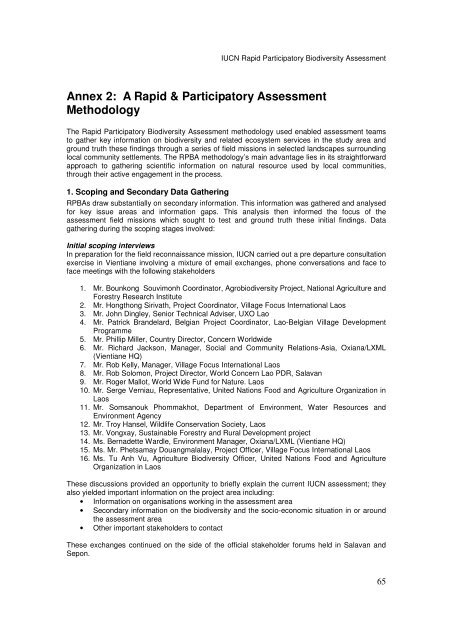Part 1 – A Rapid Participatory Biodiversity Assessment - IUCN
Part 1 – A Rapid Participatory Biodiversity Assessment - IUCN
Part 1 – A Rapid Participatory Biodiversity Assessment - IUCN
Create successful ePaper yourself
Turn your PDF publications into a flip-book with our unique Google optimized e-Paper software.
<strong>IUCN</strong> <strong>Rapid</strong> <strong>Part</strong>icipatory <strong>Biodiversity</strong> <strong>Assessment</strong><br />
Annex 2: A <strong>Rapid</strong> & <strong>Part</strong>icipatory <strong>Assessment</strong><br />
Methodology<br />
The <strong>Rapid</strong> <strong>Part</strong>icipatory <strong>Biodiversity</strong> <strong>Assessment</strong> methodology used enabled assessment teams<br />
to gather key information on biodiversity and related ecosystem services in the study area and<br />
ground truth these findings through a series of field missions in selected landscapes surrounding<br />
local community settlements. The RPBA methodology’s main advantage lies in its straightforward<br />
approach to gathering scientific information on natural resource used by local communities,<br />
through their active engagement in the process.<br />
1. Scoping and Secondary Data Gathering<br />
RPBAs draw substantially on secondary information. This information was gathered and analysed<br />
for key issue areas and information gaps. This analysis then informed the focus of the<br />
assessment field missions which sought to test and ground truth these initial findings. Data<br />
gathering during the scoping stages involved:<br />
Initial scoping interviews<br />
In preparation for the field reconnaissance mission, <strong>IUCN</strong> carried out a pre departure consultation<br />
exercise in Vientiane involving a mixture of email exchanges, phone conversations and face to<br />
face meetings with the following stakeholders<br />
1. Mr. Bounkong Souvimonh Coordinator, Agrobiodiversity Project, National Agriculture and<br />
Forestry Research Institute<br />
2. Mr. Hongthong Sirivath, Project Coordinator, Village Focus International Laos<br />
3. Mr. John Dingley, Senior Technical Adviser, UXO Lao<br />
4. Mr. Patrick Brandelard, Belgian Project Coordinator, Lao-Belgian Village Development<br />
Programme<br />
5. Mr. Phillip Miller, Country Director, Concern Worldwide<br />
6. Mr. Richard Jackson, Manager, Social and Community Relations-Asia, Oxiana/LXML<br />
(Vientiane HQ)<br />
7. Mr. Rob Kelly, Manager, Village Focus International Laos<br />
8. Mr. Rob Solomon, Project Director, World Concern Lao PDR, Salavan<br />
9. Mr. Roger Mallot, World Wide Fund for Nature. Laos<br />
10. Mr. Serge Verniau, Representative, United Nations Food and Agriculture Organization in<br />
Laos<br />
11. Mr. Somsanouk Phommakhot, Department of Environment, Water Resources and<br />
Environment Agency<br />
12. Mr. Troy Hansel, Wildlife Conservation Society, Laos<br />
13. Mr. Vongxay, Sustainable Forestry and Rural Development project<br />
14. Ms. Bernadette Wardle, Environment Manager, Oxiana/LXML (Vientiane HQ)<br />
15. Ms. Mr. Phetsamay Douangmalalay, Project Officer, Village Focus International Laos<br />
16. Ms. Tu Anh Vu, Agriculture <strong>Biodiversity</strong> Officer, United Nations Food and Agriculture<br />
Organization in Laos<br />
These discussions provided an opportunity to briefly explain the current <strong>IUCN</strong> assessment; they<br />
also yielded important information on the project area including:<br />
• Information on organisations working in the assessment area<br />
• Secondary information on the biodiversity and the socio-economic situation in or around<br />
the assessment area<br />
• Other important stakeholders to contact<br />
These exchanges continued on the side of the official stakeholder forums held in Salavan and<br />
Sepon.<br />
65

















